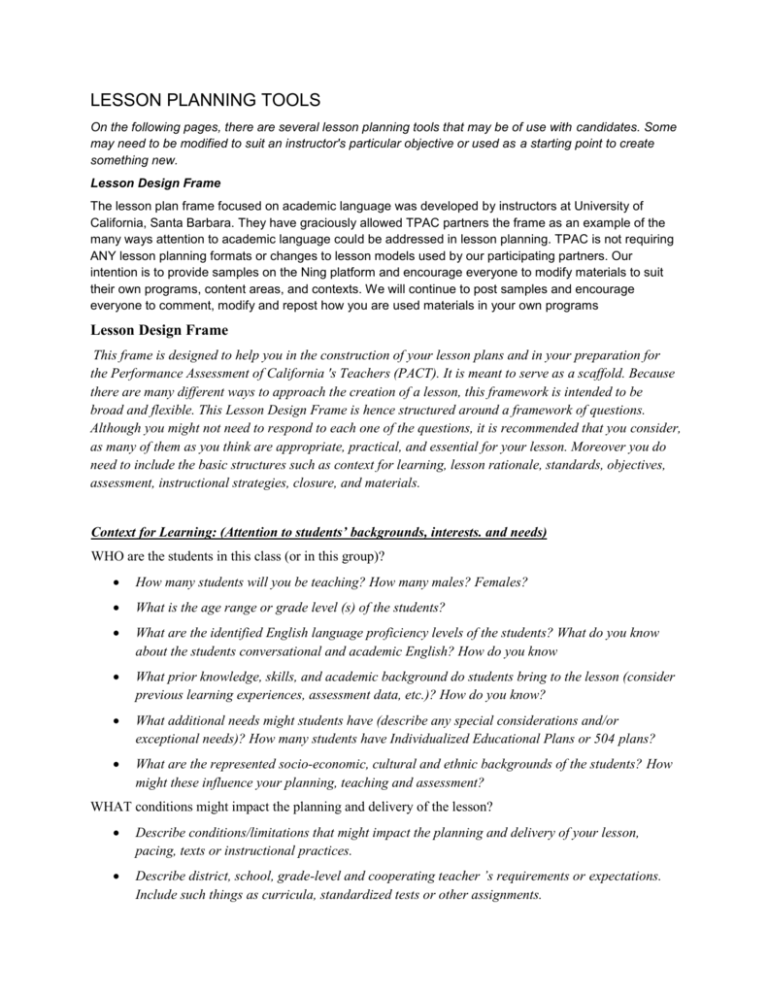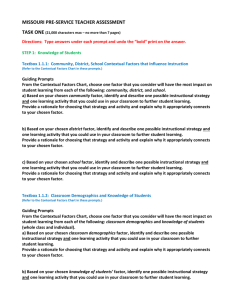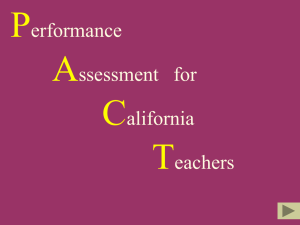Lesson Plan Outline.pdfx - Teachers College Columbia University
advertisement

LESSON PLANNING TOOLS On the following pages, there are several lesson planning tools that may be of use with candidates. Some may need to be modified to suit an instructor's particular objective or used as a starting point to create something new. Lesson Design Frame The lesson plan frame focused on academic language was developed by instructors at University of California, Santa Barbara. They have graciously allowed TPAC partners the frame as an example of the many ways attention to academic language could be addressed in lesson planning. TPAC is not requiring ANY lesson planning formats or changes to lesson models used by our participating partners. Our intention is to provide samples on the Ning platform and encourage everyone to modify materials to suit their own programs, content areas, and contexts. We will continue to post samples and encourage everyone to comment, modify and repost how you are used materials in your own programs Lesson Design Frame This frame is designed to help you in the construction of your lesson plans and in your preparation for the Performance Assessment of California 's Teachers (PACT). It is meant to serve as a scaffold. Because there are many different ways to approach the creation of a lesson, this framework is intended to be broad and flexible. This Lesson Design Frame is hence structured around a framework of questions. Although you might not need to respond to each one of the questions, it is recommended that you consider, as many of them as you think are appropriate, practical, and essential for your lesson. Moreover you do need to include the basic structures such as context for learning, lesson rationale, standards, objectives, assessment, instructional strategies, closure, and materials. Context for Learning: (Attention to students’ backgrounds, interests. and needs) WHO are the students in this class (or in this group)? How many students will you be teaching? How many males? Females? What is the age range or grade level (s) of the students? What are the identified English language proficiency levels of the students? What do you know about the students conversational and academic English? How do you know What prior knowledge, skills, and academic background do students bring to the lesson (consider previous learning experiences, assessment data, etc.)? How do you know? What additional needs might students have (describe any special considerations and/or exceptional needs)? How many students have Individualized Educational Plans or 504 plans? What are the represented socio-economic, cultural and ethnic backgrounds of the students? How might these influence your planning, teaching and assessment? WHAT conditions might impact the planning and delivery of the lesson? Describe conditions/limitations that might impact the planning and delivery of your lesson, pacing, texts or instructional practices. Describe district, school, grade-level and cooperating teacher ’s requirements or expectations. Include such things as curricula, standardized tests or other assignments. What classroom management issues might instruction? How might you proactively address those issues in your lesson design? Lesson Rationale: WHY are you teaching this lesson? Upon what assessment data or previous lessons are you building? WHAT requisite skills do students need in order to access the lesson & participate fully? How does the content build on what the students already know and are able to do? HOW does this lesson fit in the curriculum? How does the lesson build on previous lessons or previous learning? How will the learning in this lesson be further developed in subsequent lessons? Content Standards and ELD (as appropriate): Cite the grade level and standards using the numbers as well as the text. Use only the relevant parts to hello focus your lesson planning. Content Information: What do you, as the teacher, know about this particular concept/topic/etc.? Where did you find this information? (List specific resources). Learning Objectives (Established Goals): WHAT do you want students to think, know understand and/or be able to do (identify, give examples, compare, use, design, judge, etc.). Be specific and use concrete terms. HOW will students demonstrate this? Describe observable actions. You may use the following sentence frame: Given (learning activities or teaching strategies), the learners will (assessable behaviors) in order to demonstrate (connection to standards). Language Objectives: WHAT do you want students to think, know understand and/or be able to do with language (identify, give examples, compare, describe, retell, summarize, etc.). Be specific and use concrete terms. HOW will students demonstrate their English language development within the context of the content lesson? Describe observable actions. Academic Language What key vocabulary (content-specific terms) do you need to teach and how will you teach students that vocabulary in the lesson? Academic language functions: What are students doing with language to express their developing understanding of the content you are teaching? Linguistic forms: What words and phrases do students need in order to express their understanding of the content you are teaching? How will you teach students the grammatical constructions (this is where you identify sentence frames)? What opportunities will you provide for students to practice the new language and develop fluency (written or oral)? Formative Assessment (Process): How will you know that the students are learning/working towards your goals? How will students demonstrate their understanding? In what ways will you monitor student learning during the lesson and how might this guide your instruction? What specific actions do you expect to observe? How will you record what you see and hear? What criteria will you use to judge whether your students are/are not meeting the goals of the lesson? What feedback will you provide? How will your feedback support students in meeting the goals of the lesson? Describe the ways in which you will use these assessments to inform your teaching decisions during the lesson. Summative Assessment (Product): What evidence of student learning will you collect and in what ways will the evidence document student achievement? In what ways will the evidence document student achievement? Does your assessment allow all students show what they know or have learned? How might you modify your assessment/s for the students with whom you are working? How will your students be able to reflect upon and self-assess their learning? What are your evaluative criteria (or rubric) and how do they measure student proficiency for your objectives? Evaluative criteria are categories that you use to assess student learning (e.g., the accuracy or quality of the students’ identifications, explanations, solutions, computations, analyses, applications, designs, judgments, etc. Are your assessments aligned with your objectives? You may format your responses in a grid such as the one below. It is not required that you do so. Description of Assessment Activity Evaluative Criteria What the assignment is designed to assess Feedback to Students Instructional Strategies and Learning Tasks to Support Learning: How will you communicate the learning goals and objectives to students? What explicit learning instruction occurs: what specifically are the students learning in this lesson? What learning activities do you have planned for the students (Note: these describe What the students do during the lesson) What instructional strategies will you use (Note: Instructional strategies describe what the teacher does during the lesson) Provide estimates of time. Articulate a purpose for your selection of each learning activity What are the key teacher questions or prompts? What are the procedural directions for students to follow? Will students be grouped and, if so, by what criteria? In what ways will you ensure equitable learning opportunities for all students? Time Learning Activity Orientation/ Engagement/ Motivation: (Introduction of the topic: making connections) This means applying what you know about your students’ academic and social development and cultural backgrounds to make the learning interesting, accessible and relevant.) How will you engage your students? How will you connect to your students’ previous experiences? How will you link this to their lives as students? Purpose How will you communicate your learning goals/objectives or your expectations to the students? Presentation/ Explicit Instruction: How will you explicitly teach/ model or demonstrate the skill/ strategy/ concept? How will you adapt the instructional procedures to meet the needs of the students whom you are teaching? Remember: telling is not teaching! Structured Practical/ Exploration: What learning activities do you have planned? What kind of examples/ samples will you provide for your students? How will students know where the work is going and what is expected of them? What opportunities will you provide for students to practice this new skill/strategy? What questions might you pose to check for understanding? Guided Practice/ Feedback: What additional opportunities will you provide for students to practice this new skill/strategy? What questions might you pose to push student thinking and check for understanding? What feedback do you plan to provide? How might you correct student misunderstandings? Independent Practice/ Application: What kind of opportunities will you provide students to apply this new learning and demonstrate mastery? How might students evaluate their work and its implications? Closure How will the key points of the lesson be articulated? By whom? What questions or prompts will you use to elicit student articulation of their learning? How will students rethink and revise their understanding and work? Materials What materials will you need in order to teach this lesson? What materials will students need? Management and Safety Issues: Are there management and safety issues that need to be considered when teaching this lesson? If so, list them. What will you do to prepare your students for these issues? Once you have completed the lesson plan, take a moment to analyze and reflect on what you have designed and consider the criteria of internal consistency and professional quality. You do not have to write responses to the question prompts. Internal Consistency: Are the lesson procedures consistent with objectives and assessments? Is there an apparent purpose for using the specific learning activities? Is the lesson developmentally and logically sequenced? Are the steps clear, concise and explicit? Professional Quality: Does your name appear on the lesson? Does the name of the class appear on top? Is the school site identified? Does the lesson have a title? Can someone else teach from this lesson plan? Does the formatting of the lesson plan conform to professional standards (computer printed, clearly outlined and formatted, succinct, yet complete)? Analysis of Student Work Choose three samples of student work representing the full range of student performance. At least one of these must be from an English language learner and one from a student who represents a particular teaching challenge related to your expectations for this lesson/assignment. The third is a sample of your choice. What kind(s) of feedback did you give students? How did you check for individual and group understanding? How did you feedback encourage students to move toward self-assessment? For each work sample, discuss what it illustrates about the students’ developing skills and understandings of the academic content as well as growth in academic language. o To what extent did each student learn what you had intended them to learn? Did she/he meet your goals/objectives? How/why? Cite specific evidence from the sample collected. o What do these samples tell you about each of the students in relationship to the content standard of focus? o In what areas did the each of the students have difficulty? Why? o Were the adaptations/accommodations to the lesson appropriate for each of these students? How? Why? o Was the assessment appropriate for these students? How? Why are there aspects of the student’s learning that you observed that are not well represented in the samples? Explain. Reflective Commentary (Derived from analysis of student work): Was the lesson taught as planned? If not, what changes were made to the lesson and why? To what extent did the whole class or group learn what you intended them to learn? Cite specific examples and/or evidence. (Evidence could include student work, supervisor CT observation notes, video, etc.) What did you learn about your students as learners? What will be your next steps instructionally? Why? Do you have data to support these next steps? The next time that you teach this material to a similar group of students, what changes, if any, might you make in: o Planning o Instruction o Assessment o Management and Safety How would the changes improve the learning of students with different needs and characteristics? What have you learned about yourself as a teacher? What goals do you have for yourself as you plan future lessons? What other forms of feedback could you have used? Why?











